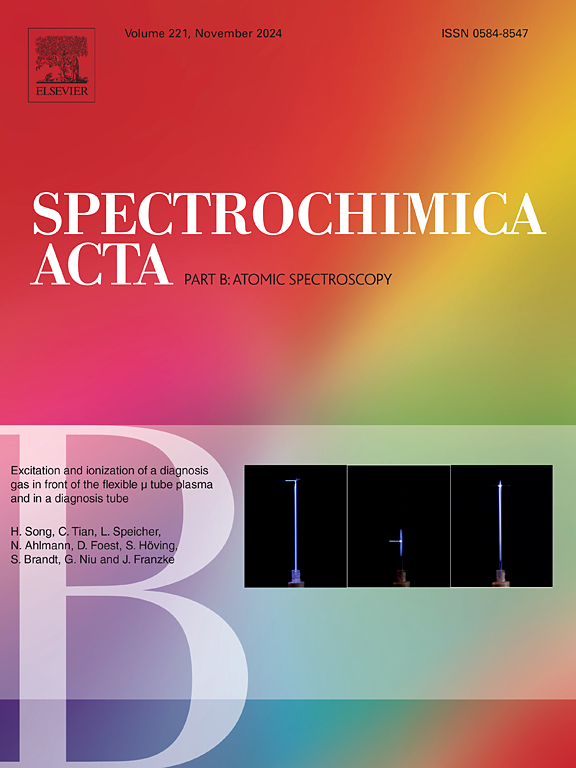电感耦合等离子体串联质谱(ICP-MS/MS)在冷等离子体/N2O反应模式下测定钆基造影剂中的钙
IF 3.8
2区 化学
Q1 SPECTROSCOPY
引用次数: 0
摘要
钙(Ca)作为一种杂质,可以通过配体竞争、沉淀形成或生物干扰等方式影响钆基造影剂(gbca)的疗效和安全性。为了满足GBCA分析检测的要求,确保GBCA的质量和安全性,提出了一种电感耦合等离子体串联质谱(ICP-MS)/MS法测定GBCA含量的新方法。样品经2%硝酸稀释后,采用ICP-MS/MS直接分析。在低温等离子体条件下,通过抑制等离子体气体Ar的低温电离,减少了40Ar+的形成。在MS/MS模式下,以N2O为反应气体,基于40Ca+与N2O通过o原子转移反应生成40Ca16O+ (40Ca+ + N2O→40Ca16O+ + N2),且其他干扰离子未与N2O发生质移反应的情况,采用质移法消除光谱干扰。通过分析标准物质(NIST SRM 1640a和NIST SRM 1643f)并进行尖峰恢复,评估了方法的准确性、可靠性和精密度。Ca的检出限(LOD)为1.35 ng L−1 (40Ca),相对标准偏差为1.8% ~ 2.7%,峰回收率为98.6% ~ 102%。因此,采用ICP-MS/MS建立了一种系统的方法来准确定量gbca中具有挑战性的元素Ca,并突出其在其他领域的潜力。本文章由计算机程序翻译,如有差异,请以英文原文为准。

Determination of calcium in gadolinium-based contrast agents using inductively coupled plasma tandem mass spectrometry (ICP-MS/MS) in the cool plasma/N2O reaction mode
Calcium (Ca), as an impurity, can affect the efficacy and safety of gadolinium-based contrast agents (GBCAs) through ligand competition, precipitation formation, or biological interference. To meet the requirements of GBCA analysis and testing and ensure the quality and safety of GBCAs, a novel strategy was proposed to determine Ca content in GBCAs using inductively coupled plasma tandem mass spectrometry (ICP-MS)/MS. The sample was directly analyzed using ICP-MS/MS after dilution with 2 % nitric acid. Under cool plasma conditions, the formation of 40Ar+ was reduced by inhibiting the ionization of the plasma gas Ar at low temperatures. In the MS/MS mode, with N2O as the reaction gas, and based on the case that 40Ca16O+ was generated through the O-atom transfer reaction between 40Ca+ and N2O (40Ca+ + N2O → 40Ca16O+ + N2) and that other interfering ions did not undergo the mass shift reaction with N2O, spectral interference was eliminated using the mass shift method. The accuracy, reliability, and precision of the method were evaluated by analyzing standard reference materials (NIST SRM 1640a and NIST SRM 1643f) and performing spike recovery. The limit of detection (LOD) of Ca was as low as 1.35 ng L−1 (obtained for 40Ca), the relative standard deviation was 1.8 %–2.7 %, and the spike recovery was 98.6 %–102 %. Thus, a systematic method was established using ICP-MS/MS to accurately quantify the challenging element Ca in GBCAs and to highlight its potential in other fields.
求助全文
通过发布文献求助,成功后即可免费获取论文全文。
去求助
来源期刊
CiteScore
6.10
自引率
12.10%
发文量
173
审稿时长
81 days
期刊介绍:
Spectrochimica Acta Part B: Atomic Spectroscopy, is intended for the rapid publication of both original work and reviews in the following fields:
Atomic Emission (AES), Atomic Absorption (AAS) and Atomic Fluorescence (AFS) spectroscopy;
Mass Spectrometry (MS) for inorganic analysis covering Spark Source (SS-MS), Inductively Coupled Plasma (ICP-MS), Glow Discharge (GD-MS), and Secondary Ion Mass Spectrometry (SIMS).
Laser induced atomic spectroscopy for inorganic analysis, including non-linear optical laser spectroscopy, covering Laser Enhanced Ionization (LEI), Laser Induced Fluorescence (LIF), Resonance Ionization Spectroscopy (RIS) and Resonance Ionization Mass Spectrometry (RIMS); Laser Induced Breakdown Spectroscopy (LIBS); Cavity Ringdown Spectroscopy (CRDS), Laser Ablation Inductively Coupled Plasma Atomic Emission Spectroscopy (LA-ICP-AES) and Laser Ablation Inductively Coupled Plasma Mass Spectrometry (LA-ICP-MS).
X-ray spectrometry, X-ray Optics and Microanalysis, including X-ray fluorescence spectrometry (XRF) and related techniques, in particular Total-reflection X-ray Fluorescence Spectrometry (TXRF), and Synchrotron Radiation-excited Total reflection XRF (SR-TXRF).
Manuscripts dealing with (i) fundamentals, (ii) methodology development, (iii)instrumentation, and (iv) applications, can be submitted for publication.

 求助内容:
求助内容: 应助结果提醒方式:
应助结果提醒方式:


